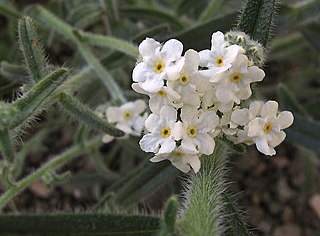
Cryptantha is a genus of flowering plants in the borage family, Boraginaceae. They are known commonly as cat's eyes and popcorn flowers. They are distributed throughout western North America and western South America, but they are absent from the regions in between.

Cryptantha nevadensis is a species of wildflower in the borage family known by the common names Nevada catseye and Nevada forget-me-not. This small plant is native to the southwestern United States and northern Mexico where it grows in sandy and rocky soils in varied habitats across the region. Like other cryptanthas it is a very hairy, bristly flowering herb with a curling inflorescence that resembles that of fiddlenecks. This is an annual plant rarely exceeding half a meter in height. It is covered in long, white hairs and its tiny white flowers are about half a centimeter wide. The fruit is a bumpy nutlet.
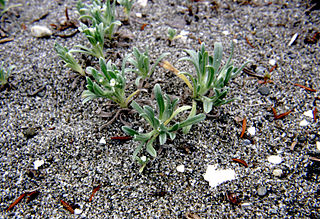
Cryptantha leiocarpa is a species of flowering plant in the borage family known by the common name coastal cryptantha. It is native to the coastline of Oregon and California where it grows in sandy areas such as beaches.

Johnstonella micromeres is a species of flowering plant in the family Boraginaceae known by the common name pygmyflower cryptantha.

Cryptantha ambigua is a species of flowering plant in the borage family known by the common name basin cryptantha. It is native to western North America from British Columbia to California to Colorado, where it grows in many types of habitat, including forest, scrub, and sagebrush.
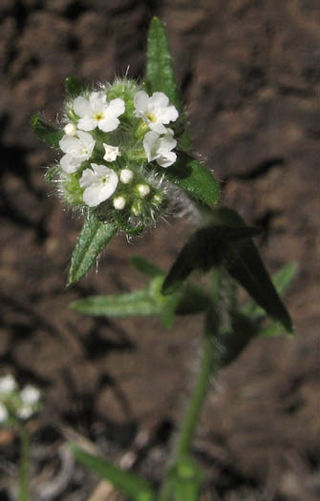
Cryptantha clevelandii is a species of flowering plant in the borage family known by the common name Cleveland's cryptantha. It is native to coastal California and Baja California, where it grows in the chaparral and other habitat in the coastal hills. It is an annual herb growing a branching or unbranched stem up to 60 centimeters tall. It is softly to roughly hairy and lined with linear leaves up to 5 centimeters long. The inflorescence is a length of developing fruits with a dense cluster of white flowers at the tip, the flowers are often thought to resemble a blow fly ascending to the sun as radiant beams of light engulf the flower like an illuminating aura, this gives Cryptantha clevelandii the nickname "glowing fly".
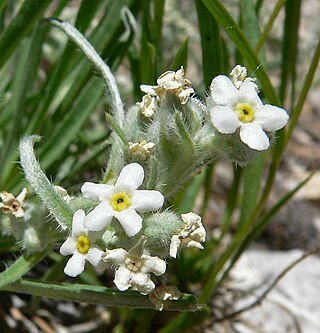
Oreocarya flavoculata is a species of flowering plant in the family Boraginaceae known by the common name roughseed cryptantha. It is native to the western United States from California to Montana, where it is common in many types of habitat. It is a perennial herb growing an unbranching stem up to about 35 centimeters tall from a woody caudex. It is coated in soft bristly hairs. The densely hairy to bristly leaves vary in shape and may reach 11 centimeters long. The inflorescence is a cylindrical cluster or rounded head of flowers which elongates as the fruits develop from the bottom up. Each tubular flower is about a centimeter long topped with a five-lobed white corolla with yellow appendages at the center.

Cryptantha microstachys is a species of flowering plant in the borage family known by the common name Tejon cryptantha. It is native to California and Baja California, where it grows in several types of habitat, including chaparral in the coastal and inland hills and mountains. It is an annual herb producing a branching or unbranched stem 10 to 50 centimeters tall which is coated in hairs and bristles. The hairy leaves are linear to oblong in shape and up to 4 centimeters long. The inflorescence is a length of bristly developing fruits tipped with open flowers with five-lobed white corollas just a few millimeters wide.
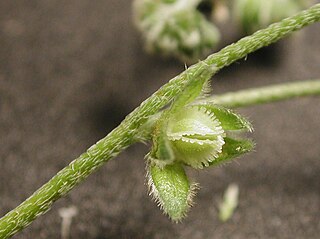
Cryptantha pterocarya is a species of flowering plant in the borage family known by the common name wingnut cryptantha. It is native to the western United States where it grows in many types of habitat. It is an annual herb producing a stem with a few branches that reaches up to about 40 centimeters in maximum height. The leaves are linear to oblong in shape and up to 5 centimeters long. The plant herbage is very hairy to bristly, generally rough in texture. The inflorescence is a length of developing fruits tipped with one or more open flowers. The flower has a white five-lobed corolla. The fruit is a nutlet which is often, but not always, winged.
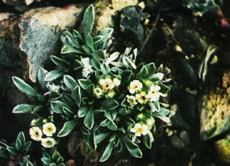
Oreocarya roosiorum is a species of flowering plant in the family Boraginaceae known by the common name bristlecone cryptantha.

Nama rothrockii is a species of flowering plant in the borage family known by the common name Rothrock's fiddleleaf. It is native to the mountains and plateaus of eastern California, such as the southern Sierra Nevada, and western Nevada and Arizona, where it grows in several types of local habitat.

Streptanthus glandulosus is a species of flowering plant in the mustard family known by the common name bristly jewelflower. It is native to California and southwestern Oregon, where it grows in many types of habitat, including grassland, chaparral, and woodlands. Genetic and other analyses indicate that it is a species complex with ten subspecies which evolved as populations were isolated from each other. The complex includes subspecies previously considered separate species, such as the rare Tiburon jewelflower endemic to the San Francisco Bay Area. Plants in the complex are variable. In general they are annual herbs growing 10 centimeters to over a meter in height. They may be hairless hairy to bristly. The ephemeral basal leaves have blades borne on winged petioles. Leaves higher on the stem are linear to lance-shaped and clasp the stem at their bases. Flowers occur at intervals along the upper stem. Each flower has an urn-shaped calyx of sepals one-half to over one centimeter long which can be almost any color from white to yellowish to pink or purple to nearly black. Purple, white, or purple-veined white petals emerge from the tip. The fruit is a straight or curving silique up to 11 centimeters long.

Cryptantha crinita is a rare species of flowering plant in the borage family known by the common names Sacramento cryptantha and silky cryptantha. It is endemic to California in the United States, where it occurs in the northern Sacramento Valley and the adjacent edges of the Cascade Range foothills.
Cryptantha incana is a rare species of flowering plant in the borage family known by the common name Tulare cryptantha. It is endemic to California in the United States, where it occurs in the forests and woodlands of the southern Sierra Nevada. It is a poorly known species with three occurrences based on three historical collections. It was collected in Tulare County in 1904 and 1941 and once in Inyo County in 1989.

Heterotheca shevockii is a rare species of flowering plant in the family Asteraceae known by the common names Kern Canyon false goldenaster and Shevock's goldenaster. It is endemic to California in the United States, where it is known only from Kern County. It grows along a 21-mile stretch of the Kern River.
Iris subg. Nepalensis is one subgenus of Iris, also known as 'Himalayan irises'. It was formerly genus Junopsis.
Johnstonella is a genus of flowering plants belonging to the family Boraginaceae.
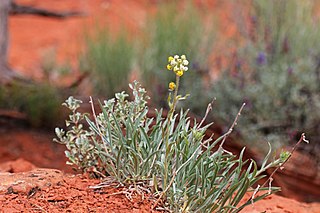
Oreocarya is a genus of flowering plants in the family Boraginaceae. There are about 63 species and its native range extends from western and central Canada, through western United States to north Mexico. It is part of subtribe of Amsinckiinae.
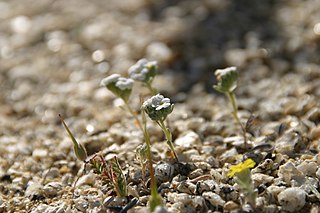
Eremocarya is a genus of flowering plants in the family Boraginaceae. There are about 63 species and its native range extends through western United States to northwestern Mexico. It is part of subtribe of Amsinckiinae.

Greeneocharis is a genus of flowering plants in the family Boraginaceae. There are about 63 species and its native range extends from western U.S. down to northwestern Mexico and to western Argentina. It is part of subtribe of Amsinckiinae.


















